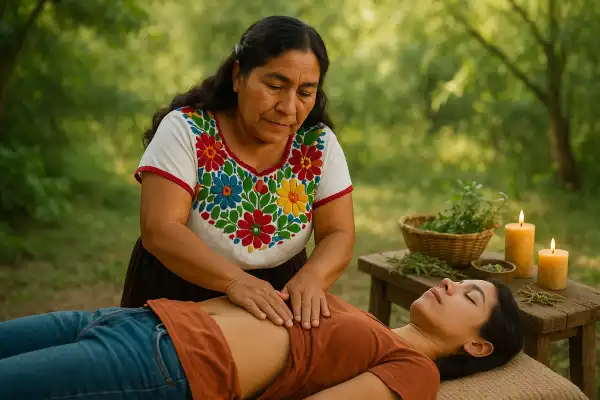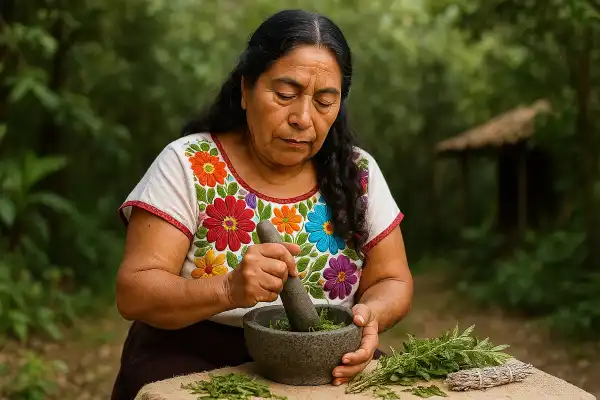Curanderismo herbs and remedies represent thousands of years of healing wisdom passed down through generations of Mexican families. Many people seek these ancestral practices when conventional approaches feel incomplete, looking for healing that addresses body, mind, and spirit together.
María del Pilar Fernández believes deeply in the power of curandera traditions, drawing from her own lineage of healers in Oaxaca to answer questions about these time-honored remedies. Through her anthropological studies and decades of practice, she seeks to bridge ancient wisdom with contemporary understanding.
Curanderismo herbs and remedies
Curanderismo herbs and remedies form the foundation of Mexican traditional medicine, a holistic healing system that has been practiced for over 5,000 years across Mexico and continues to thrive in communities worldwide. These sacred plants serve as medicine for physical ailments while simultaneously addressing spiritual and emotional imbalances that curanderas recognize as the root of many health challenges.

The sacred foundation of plant medicine
Traditional Mexican healers understand that physical illness often stems from emotional disturbances, environmental disharmony, or spiritual disconnection. Plants become allies in restoring balance across all dimensions of human experience. Each curandera develops their distinctive practice within family lineages or through spiritual calling, learning to work with plants as living teachers rather than mere substances.
The selection and preparation of herbs follows ancient protocols honoring the plant’s spirit. Harvest timing, lunar cycles, prayers, and ritual preparation transform simple botanicals into powerful healing allies. This sacred relationship distinguishes curanderismo from purely chemical approaches to plant medicine.
Essential healing herbs of curanderismo
Sábila (Aloe Vera)
Sábila stands as one of the most revered plants in Mexican traditional healing, used both topically for burns and cuts, and internally as a digestive remedy. Modern research confirms aloe vera’s anti-inflammatory and antibiotic properties, validating its traditional applications. Curanderas place aloe plants at home entrances to protect against negative spiritual influences while keeping fresh gel available for immediate healing needs.
The preparation involves carefully filleting fresh leaves to extract pure gel, which treats everything from skin conditions to stomach ulcers. Internal use requires specific guidance, as different aloe preparations serve distinct healing purposes.
Ruda (Rue)
Ruda carries powerful protective and cleansing properties in curanderismo, commonly used for menstrual support and spiritual purification. This herb contains alkaloid-rich oils that function as antispasmodic and muscle relaxants, particularly effective for menstrual cramps. Curanderas often include ruda in limpias (spiritual cleansings) to remove negative energies.
Traditional preparation combines equal parts ruda, romero, and albahaca in alcohol to create powerful liniments for rheumatic conditions. However, ruda requires careful dosing, as concentrated preparations can be toxic.
Romero (Rosemary)
Romero brings clarity, memory enhancement, and spiritual protection to curanderismo practice. Beyond its culinary uses, rosemary stimulates circulation, supports cognitive function, and serves as a powerful tool for energy cleansing. Curanderas burn rosemary to purify spaces and include it in baths for mental clarity.
The aromatic compounds in rosemary essential oil provide therapeutic benefits when applied to temples for headaches or added to massage oils for muscle tension.
Yerbabuena (Mint)
Yerbabuena, literally meaning “good herb,” encompasses various mint species used throughout Mexican healing traditions. This versatile plant appears in digestive teas, cooling drinks during hot weather, and ceremonial preparations. Curanderas rely on mint’s cooling properties to calm heated emotions and soothe digestive disturbances.
Fresh mint leaves prepared as tea address nausea, indigestion, and nervous tension. The plant’s uplifting energy makes it valuable for emotional healing and spiritual clarity.
Albahaca (Basil)
Albahaca holds special significance in curanderismo for protection, love, and healing. Mexican basil offers analgesic properties, making it effective for pain relief and migraine treatment when applied as essential oil to temples. Maya cultures place albahaca on altars to ward off malevolent spirits and negative energies.
Traditional preparations include basil in menstrual regulation formulas and anti-fungal treatments. The herb’s memory-enhancing properties align with its spiritual role in maintaining clarity and focus during healing work.
Traditional preparation methods
Curanderismo employs specific techniques for extracting plant medicine’s full potential. Solar and lunar infusions capture different energetic qualities. Prayer and intention during preparation amplify healing properties. Many remedies combine multiple herbs, creating synergistic effects that address complex health patterns.
Teas typically use one tablespoon of dried herbs per cup of boiling water, steeped for specific durations based on the plant’s properties. Alcohol tinctures extract different compounds than water preparations, offering concentrated medicine for acute conditions. Topical applications range from fresh plant poultices to oil-based liniments.
Integration with modern healing
Contemporary curanderismo often integrates with conventional medical care, offering complementary support that addresses aspects of healing beyond physical symptoms. Research increasingly validates traditional uses of many Mexican medicinal plants, confirming their safety and efficacy when properly prepared and administered.
Successful integration requires understanding both systems’ strengths. Curanderismo excels at treating spiritual and emotional dimensions of illness, while modern medicine provides essential acute care and diagnostic capabilities. Many families combine both approaches for comprehensive healing.
Seasonal and ceremonial uses
Curanderas align herb gathering and preparation with natural cycles. Spring plants carry renewal energy perfect for cleansing protocols. Summer herbs offer peak vital force for strength-building remedies. Autumn preparations help with releasing and letting go, while winter medicine supports deep healing and restoration.
Ceremonial applications include herbs in altars, blessing ceremonies, and life transition rituals. Plants serve as bridges between physical and spiritual realms, facilitating healing that encompasses all aspects of human experience.
Disclaimer
Please note that Maria is not a physician, psychologist, or nurse. These culture-specific spiritual healing services are not meant to replace medical or psychological diagnosis and treatment. It is recommended that you see a licensed physician or licensed health care professional for any physical or psychological ailment you may have.
Last spring, María worked with a young woman named Esperanza who had been struggling with chronic digestive issues that conventional treatments hadn’t fully resolved. After proper medical evaluation ruled out serious conditions, Esperanza sought curanderismo support for the emotional stress that seemed connected to her physical symptoms. María prepared a gentle tea blend combining yerbabuena for digestive soothing, albahaca for emotional balance, and a small amount of sábila gel for internal healing.
The preparation included prayers for Esperanza’s complete healing and instructions for mindful tea drinking while contemplating what needed to be released from her life. Over several weeks, combining this plant medicine with meditation and dietary awareness, Esperanza found not only digestive relief but also clarity about relationship patterns that had been causing her stress. The plants served as allies in her journey toward wholeness, supporting both physical healing and emotional transformation that addressed the root causes of her discomfort.

